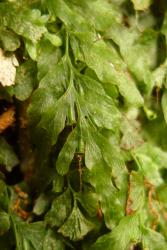- = Abrodictyum C.Presl, Hymenophyllaceae 20, t. 7 (1843)
- = Trichomanes subgen. Crepidomanes C.Presl, Epimel. Bot. 17 (1851)
- ≡ Crepidomanes (C.Presl) C.Presl, Epimel. Bot. 258 (1851)
- = Phlebiophyllum Bosch, Verslagen Meded. Afd. Natuurk. Kon. Akad. Wetensch. 11: 321 (1861)
- ≡ Polyphlebium Copel., Philipp. J. Sci. 67: 55 (1938) nom. nov. pro Phlebiophyllum Bosch 1861 (non Phlebophyllum Nees 1832)
Epiphytic, terrestrial or rupestral ferns. Rhizomes erect or short to long-creeping, filiform to rather thick, bearing dense multicellular light brown or red-brown or blackish hairs; roots absent or few and fine or numerous and robust. Fronds monomorphic. Laminae entire (not NZ) or 1–4-pinnatifid (NZ) or 1–3-pinnate (NZ) or 4–5-pinnate (not NZ), membranous and usually one cell thick, or with multistratose false veins present either side of true veins (not NZ), often translucent, glabrous or hairy; margins entire or shallowly lobed, sometimes a single row of elongate marginal cells forming a distinct border. Veins free. Sori terminating veins at margins of lamina. Indusia tubular to campanulate, widened or not at the mouth; receptacles long-exserted. Spores trilete, radially symmetrical, papillate to echinate.
Ebihara et al. (2006) recognised eight genera (Abrodictyum, Callistopteris, Cephalomanes, Crepidomanes, Didymoglossum, Polyphlebium, Trichomanes and Vandenboschia) within the trichomanoid clade, each with one to four subgenera. Of these, three (Abrodictyum, Polyphlebium and Crepidomanes) are represented in New Zealand. However, following Allan (1961) and Brownsey & Smith-Dodsworth (2000), only one umbrella genus is accepted here in the interest of nomenclatural stability and because of the difficulty of distinguishing the three segregate genera morphologically.
| 1 | Rhizomes erect | 2 |
| Rhizomes long-creeping | 3 | |
| 2 | Laminae narrowly elliptic, medium green; a single unbranched vein in each ultimate lamina segment | strictum |
| Laminae broadly triangular, dark olive-green; veins forking several times in each ultimate lamina segment | elongatum | |
| 3 | Ultimate lamina segments lacking a distinct border | 4 |
| Ultimate lamina segments with a distinct border | 5 | |
| 4 | Plants epiphytic; laminae light green; veins prominent, forking many times in each ultimate segment; sori sunk in lamina | venosum |
| Plants terrestrial or rupestral; laminae dark green; veins obscure, forking 1–2 times in each ultimate segment; sori stalked | colensoi | |
| 5 | Lamina border comprising short cells with transverse end-walls | caudatum |
| Lamina border comprising elongated cells with oblique end-walls | 6 | |
| 6 | Lamina border unistratose; roots few and fine | endlicherianum |
| Lamina border bistratose; roots absent | humile |
Trichomanes is characterised morphologically by its tubular or campanulate indusia and receptacles that are usually long-exserted, in contrast to those in Hymenophyllum which are bivalvate, or rarely urceolate, with receptacles usually included within the valves, or rarely shortly exserted. The rhizomes in species of Trichomanes are abundantly covered in red-brown hairs, whereas those in Hymenophyllum are generally almost glabrous or bear only scattered hairs near the stipe bases.
A genus of about 260 species distributed in south temperate regions and montane areas of the tropics (Iwatsuki in Kramer & Green 1990). 7 species in New Zealand; 3 endemic.
| Category | Number |
|---|---|
| Indigenous (Endemic) | 3 |
| Indigenous (Non-endemic) | 4 |
| Total | 7 |
Base chromosome numbers of x = 32 to 36 are recorded for Trichomanes (Ebihara et al. 2006).
The synonymy given here only includes names relevant to New Zealand.




